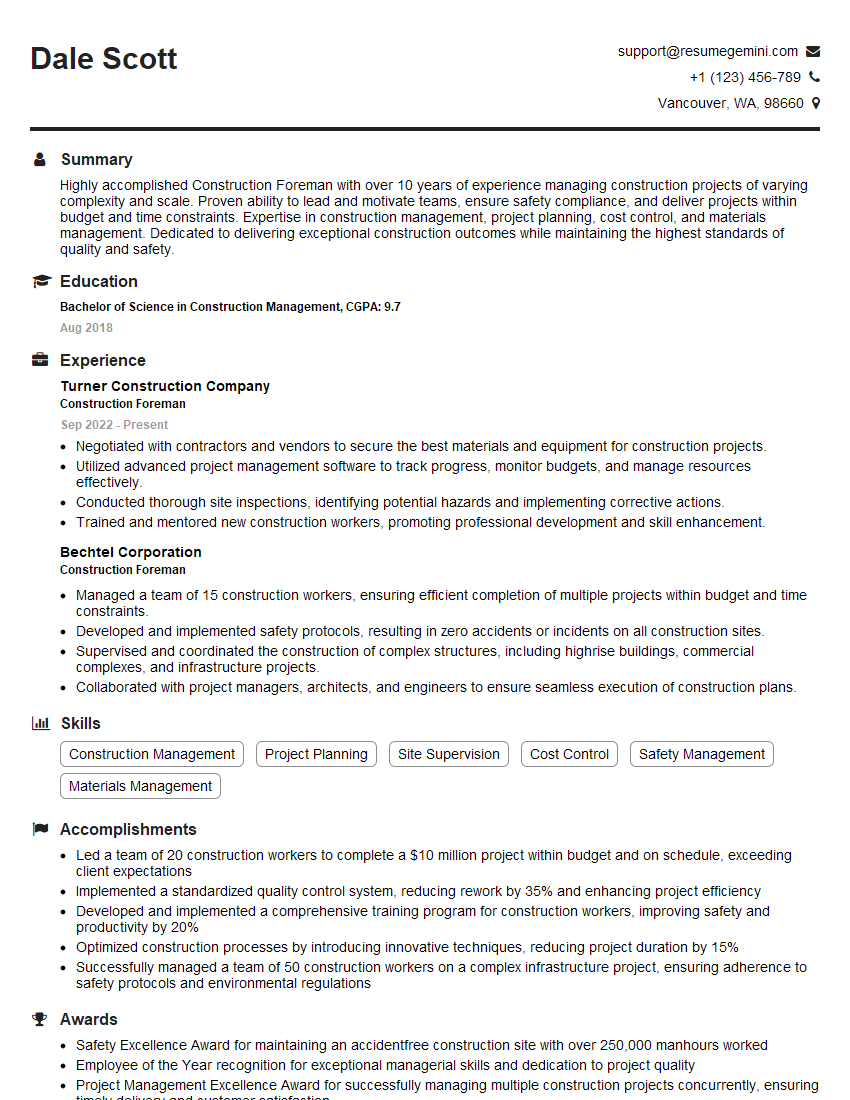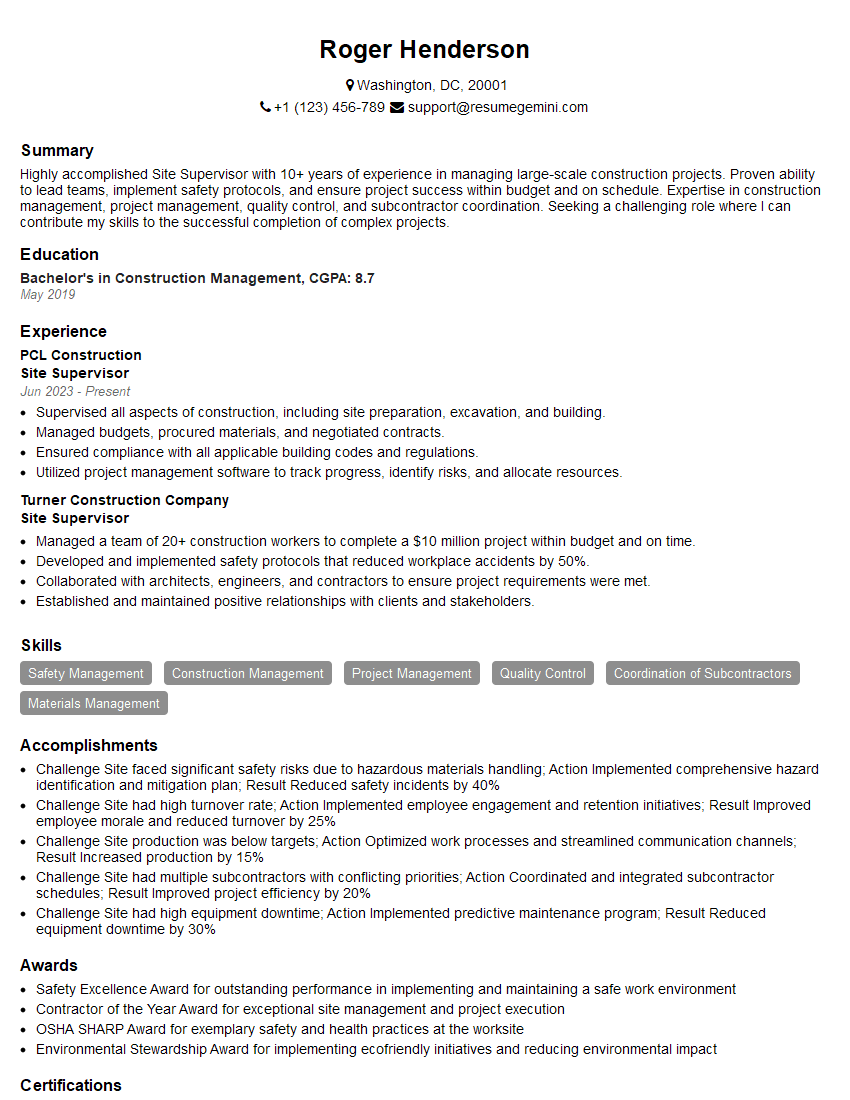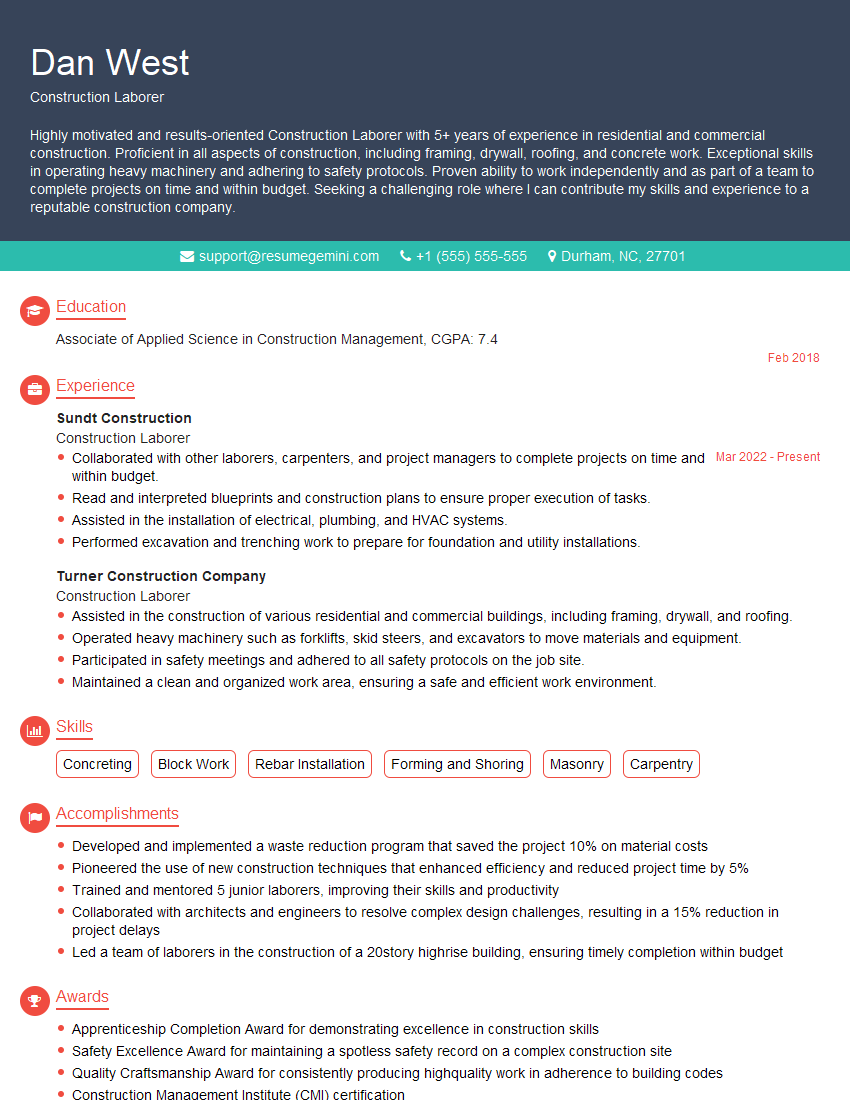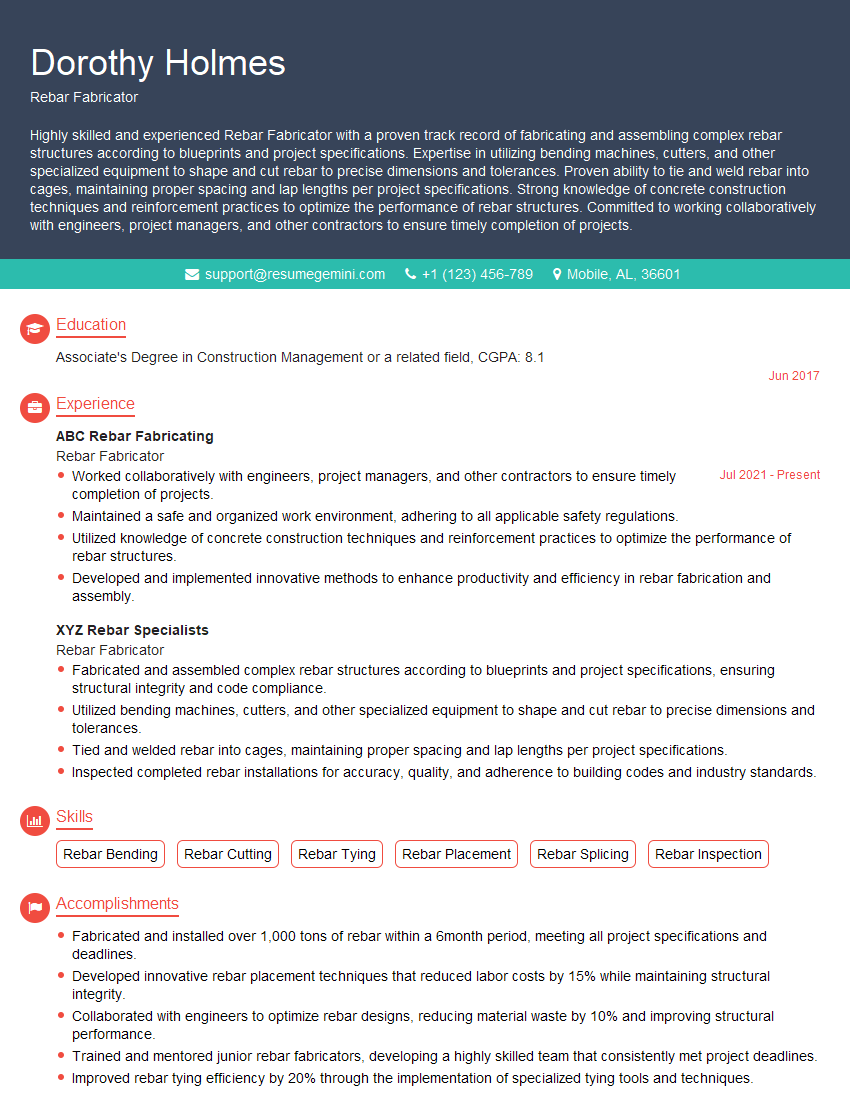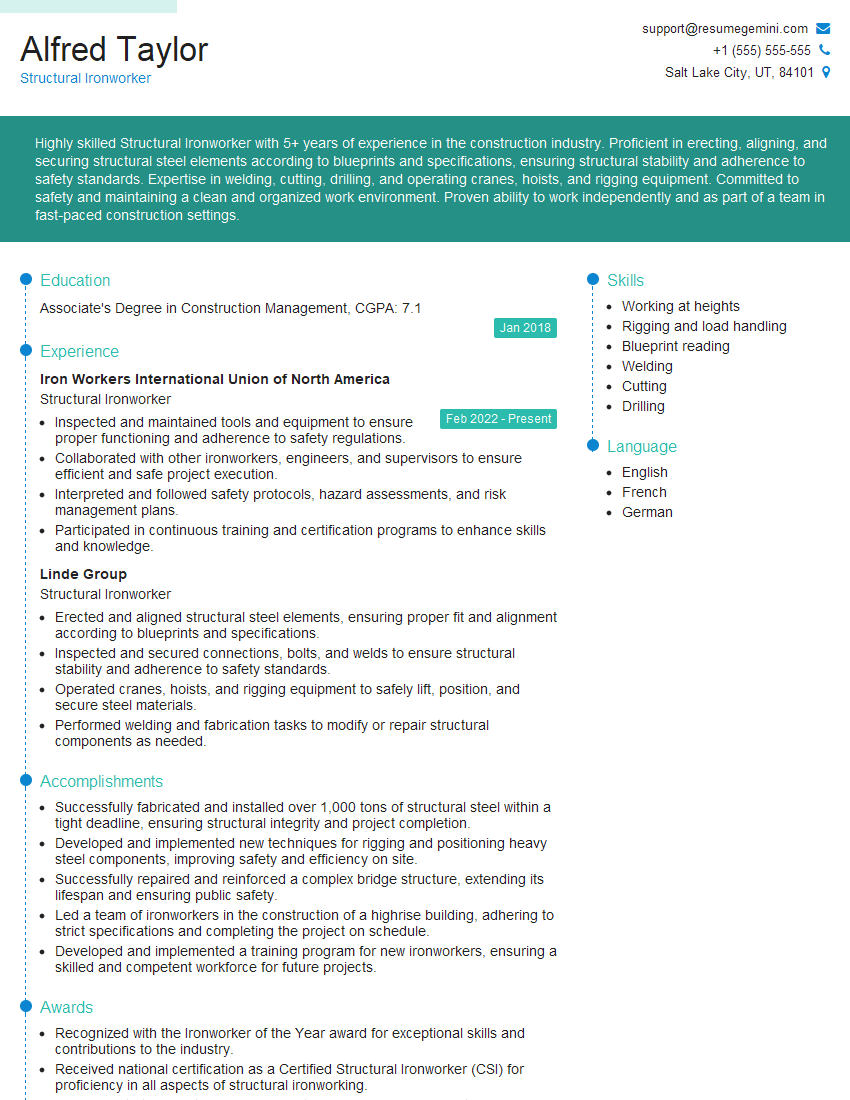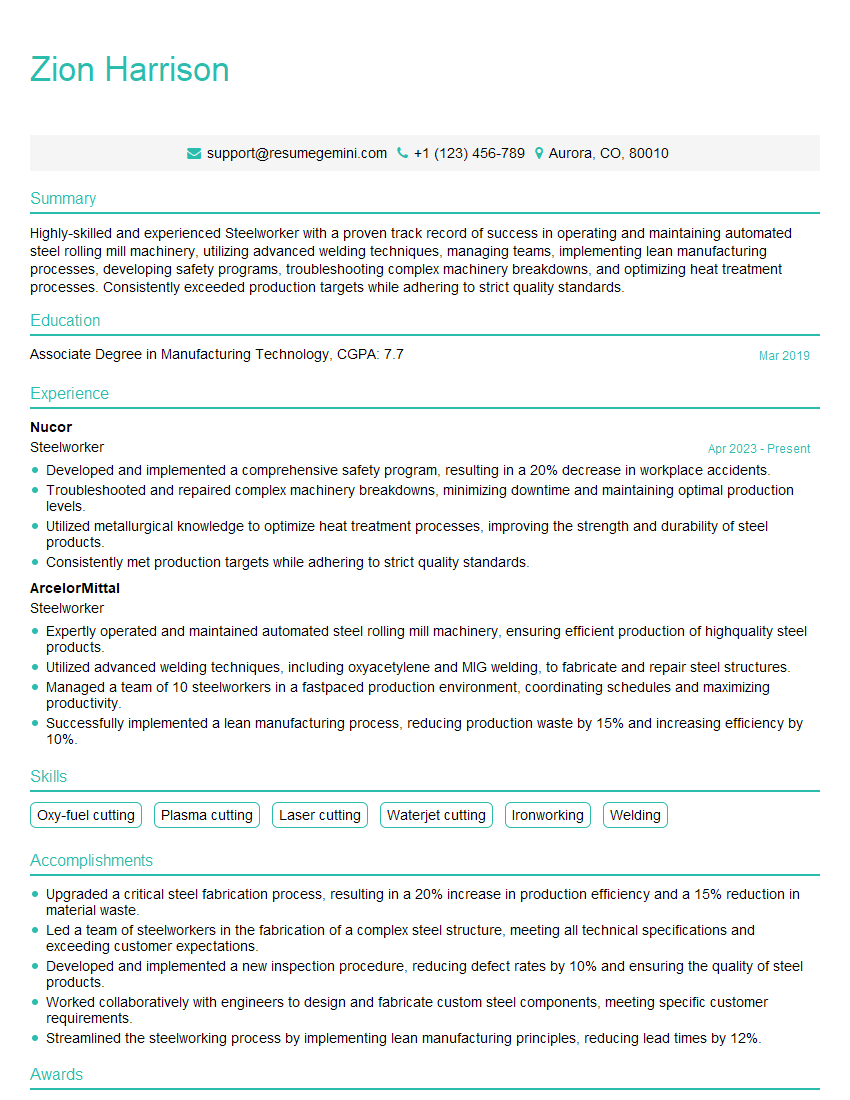The right preparation can turn an interview into an opportunity to showcase your expertise. This guide to Rebar Tying Techniques interview questions is your ultimate resource, providing key insights and tips to help you ace your responses and stand out as a top candidate.
Questions Asked in Rebar Tying Techniques Interview
Q 1. Describe the different types of rebar ties you are familiar with.
Rebar tying involves securing reinforcing steel bars (rebar) together to create a strong, stable framework for concrete structures. Several tie types exist, each suited to different situations and rebar sizes. The most common include:
- Wire Ties: These are small, pre-formed wire loops that are twisted around intersecting rebar. They are efficient and commonly used for smaller diameter bars and simpler layouts. Think of them like tiny metal zip ties for rebar.
- Twist Ties: These are lengths of annealed wire that are manually twisted around intersecting rebar using a twisting tool. They offer more flexibility in terms of placement and strength, particularly for larger diameter bars and complex configurations. Imagine using a pair of pliers to tightly wrap and twist wire around the bars.
- Plastic Rebar Ties/Clips: These are plastic components that clip onto intersecting bars and hold them together. While less sturdy than wire ties, they are faster to install for certain applications, especially with smaller diameter bars, and leave no sharp ends to worry about.
- Welded Wire Mesh (WWF): In some cases, prefabricated welded wire mesh acts as the reinforcing material, eliminating the need for individual ties between bars within the mesh. This is often seen in slab construction.
The choice of tie type depends on the project’s specifications, the rebar diameter, and the complexity of the structure.
Q 2. Explain the importance of proper spacing and alignment of rebar.
Proper spacing and alignment of rebar are absolutely crucial for the structural integrity of the concrete element. Incorrect spacing weakens the concrete, creating areas prone to cracking or failure. Misaligned bars can lead to uneven stress distribution, significantly reducing the overall strength and stability of the structure. Think of it like building a brick wall – if the bricks aren’t aligned and spaced correctly, the whole wall will be weak.
- Spacing: Consistent spacing ensures uniform concrete coverage and stress distribution. The exact spacing is dictated by engineering drawings and building codes, which vary depending on the type of structure and its intended load.
- Alignment: Precise alignment of bars prevents localized stress concentrations that could lead to premature failure. This ensures that forces are evenly distributed throughout the structure.
Using a rebar bender and ensuring accurate measurements before and during the tying process are essential to maintain proper spacing and alignment.
Q 3. How do you ensure the strength and stability of your rebar ties?
The strength and stability of rebar ties are paramount. A poorly tied intersection can lead to rebar shifting during the concrete pour, resulting in structural weaknesses. We ensure strong ties by:
- Tightening: Wire ties must be twisted tightly, leaving no slack. For twist ties, I use the rebar tying tool to achieve a firm, secure bond. For plastic ties, ensure they are securely locked in place.
- Proper Overlap: Sufficient overlap is essential to prevent slippage. Specifications often dictate minimum overlap lengths for various bar sizes.
- Correct Tie Selection: Choosing the appropriate tie type for the bar diameter and anticipated stress is vital. Larger diameter rebar demands stronger ties such as twist ties or specialized clamps.
- Visual Inspection: After tying, I always visually inspect each intersection to ensure there’s no movement or looseness.
Regular checks, use of appropriate tools, and adherence to specified standards are key to creating strong and stable rebar connections.
Q 4. What safety precautions do you take when tying rebar?
Safety is always the top priority. Working with rebar involves sharp edges and heavy materials, so I consistently practice these precautions:
- Safety Glasses: Protect eyes from flying debris and sparks.
- Gloves: Prevent cuts and abrasions from sharp rebar ends.
- Steel-Toed Boots: Protect feet from dropped objects.
- Proper Lifting Techniques: Avoid back injuries by lifting rebar correctly, using mechanical assistance if necessary.
- Awareness of Surroundings: Be mindful of other workers and potential hazards on the construction site.
- Using appropriate tools: Ensure all tools are in good working condition and are used correctly.
I always follow site-specific safety regulations and ensure all team members adhere to the same standards.
Q 5. How do you handle different diameters of rebar during tying?
Different rebar diameters require different tying techniques and, sometimes, different tools. Smaller diameter bars (e.g., #3, #4) can often be tied efficiently with wire ties or plastic clips. Larger diameter bars (#5 and above) generally require twist ties for increased strength and security. I adapt my methods by:
- Using the Right Tie Type: Choosing the right tool and tie material (wire gauge) based on rebar size as mentioned earlier. Thicker wire is needed for larger diameter bars.
- Adjusting Tie Placement: Strategic placement is more critical with larger diameter bars to avoid uneven stress distribution.
- Multiple Ties: For larger bars or high-stress applications, using multiple ties per intersection may be required.
Experience allows me to instinctively select the best tying method for any combination of bar sizes in the given situation.
Q 6. What are the common challenges you face during rebar tying, and how do you overcome them?
Several challenges can arise during rebar tying. Some common ones include:
- Difficult Access: Tight spaces and complex layouts can make tying challenging. I overcome this by using smaller, more flexible tools and taking extra time to ensure precise placement.
- Rebar Congestion: In dense reinforcing configurations, tying becomes difficult. Proper planning and pre-assembly of smaller sections can help manage this.
- Weather Conditions: Extreme heat or cold can affect the efficiency and ease of tying. We adjust schedules and adapt methods to mitigate weather-related challenges.
- Incorrect Bar Placement: If the rebar isn’t placed correctly beforehand, tying becomes incredibly difficult. I collaborate closely with the ironworkers to ensure accurate positioning.
Problem-solving involves a combination of adaptability, experience, and careful planning. When difficulties arise, I prioritize safe and efficient solutions while maintaining the structural integrity of the connections.
Q 7. Describe your experience with various rebar tying tools.
My experience encompasses various rebar tying tools, from basic manual tools to more specialized equipment:
- Manual Tie Twisters: These are essential for twist ties, providing leverage for efficient twisting. I’m proficient in using various sizes and types to match different wire gauges.
- Rebar Bending Tools: While not directly tying tools, they allow precise positioning and shaping of rebar for easier tying.
- Automatic Tie Wire Guns: These tools speed up tying, particularly in large-scale projects and for consistent wire tie applications. However, they are not as versatile as manual tools for tricky placements.
- Plastic Tie Guns and other specialized tools: For certain projects, specific tools are employed which fasten the plastic ties. This accelerates work and ensures consistent placement of plastic clips.
Choosing the right tool for the job is critical for both efficiency and safety. My experience allows me to effectively use all of these tools, depending on the project demands.
Q 8. How do you ensure the accuracy of your rebar placement according to the blueprints?
Ensuring accurate rebar placement is paramount to the structural integrity of any concrete structure. It begins with a thorough understanding of the blueprints. I always start by carefully reviewing the drawings, noting all dimensions, bar sizes, spacing, and detailing. This includes checking for any revisions or addendums. Then, I establish a clear layout on the ground, often using string lines and measuring tapes to mark out the exact positions for each bar. I double-check these measurements against the plans multiple times. During the actual placement, I regularly compare the positions of the rebar with the blueprints, using a tape measure and level to verify accuracy. If any discrepancies arise, I immediately consult with the foreman or engineer to resolve them before proceeding. Think of it like building with LEGOs; every piece needs to be in the precisely correct spot for the final structure to stand strong. Any deviation can compromise the whole thing.
For example, if the blueprint specifies 12” spacing between #4 bars, I’ll use a measuring tape and spacer to guarantee that spacing. Before pouring concrete, I’ll do a final visual inspection, looking for any irregularities that could indicate misplaced or misaligned rebar. This meticulous approach guarantees accurate rebar placement and reduces potential issues later on.
Q 9. What is your experience with working from blueprints or drawings?
I have extensive experience interpreting and working from construction blueprints and drawings. Over the past [Number] years, I’ve worked on a diverse range of projects, including residential buildings, commercial structures, and infrastructure projects. I am proficient in reading architectural, structural, and reinforcing steel drawings, understanding symbols, callouts, and details. My experience ranges from understanding simple plans for small-scale projects to intricate designs for large, complex structures. I am adept at identifying key details, such as bar sizes, spacing, bends, and connections. I have frequently used AutoCAD and Revit to review and understand 3D models as well which allows for a better spatial understanding of the rebar layout.
I remember one project where the drawings were quite complex, involving intricate detailing for the foundation of a high-rise building. My ability to interpret the multiple views and dimensions within the drawings allowed me to accurately create and verify the rebar cage layout. This is an example where even minor errors could have caused significant issues.
Q 10. Explain your understanding of different concrete reinforcement details.
My understanding of concrete reinforcement details encompasses a wide range of elements crucial for structural integrity. This includes understanding different types of reinforcement, such as:
- Column Reinforcement: This involves tying vertical bars (main bars) with ties or spirals to provide confinement and resist compressive forces.
- Beam Reinforcement: This often requires top and bottom bars, often with stirrups, to handle bending moments and shear forces. I understand the importance of proper detailing for crack control and shear capacity.
- Slab Reinforcement: This typically includes mats of bars laid out in two directions to provide tensile strength and distribute loads evenly. I’m familiar with various methods like wire mesh or individual bars.
- Wall Reinforcement: This requires vertical and horizontal bars, often spaced according to design requirements. I pay close attention to how these bars connect at corners and openings.
- Foundation Reinforcement: From simple footings to complex raft foundations, I understand the reinforcement requirements based on soil conditions and loads.
Beyond the basic element types, I’m well-versed in lap splices, dowel bars, and chair supports – essential for transferring loads and ensuring proper connection between different elements.
Q 11. Describe your experience with different types of concrete structures.
My experience spans a variety of concrete structures, encompassing residential, commercial, and industrial projects. I’ve worked on:
- High-rise buildings: Involved in complex rebar layouts for columns, beams, and slabs that require precise detailing and coordination.
- Bridges: Experience working on both girder and slab bridges, understanding the specific reinforcement requirements for these demanding applications.
- Residential structures: Familiar with the typical rebar arrangements found in foundations, walls, slabs, and beams of houses and apartments.
- Commercial buildings: Experienced with more extensive concrete designs including larger floor slabs, complicated column arrangements, and heavy loads.
- Industrial facilities: This includes projects with heavy-duty concrete foundations, retaining walls, and other structures needing robust reinforcement.
This diverse experience allows me to adapt quickly to the specific requirements of different projects. I have developed a sharp understanding of the relationship between the structural design and the reinforcement techniques. This ensures the final construction adheres to the design specifications and safety codes.
Q 12. How do you maintain consistency and speed in your rebar tying?
Maintaining consistency and speed in rebar tying requires a combination of skill, organization, and efficient work habits. I prioritize:
- Proper Preparation: Before beginning, I always ensure that I have all the necessary materials, tools, and plans readily available. This organized approach minimizes downtime and increases efficiency.
- Efficient Tying Techniques: I use the most efficient tying methods for different scenarios. For example, I utilize techniques like using a rebar tying tool that will speed up the overall process when appropriate, but I also ensure the quality of the tie is not compromised.
- Ergonomics: I maintain proper posture and work techniques to avoid fatigue. This helps prevent errors and maintains speed without sacrificing quality.
- Teamwork: When working in a team, clear communication and coordination are essential. We often divide tasks strategically to maximize efficiency.
For instance, when working on repetitive tasks, I establish a rhythm to ensure consistent speed and quality. I regularly self-check to ensure the consistency of my work throughout the process. Consistent, high-quality work leads to both speed and quality, minimizing errors and rework.
Q 13. What are the signs of incorrectly tied rebar, and how do you address them?
Incorrectly tied rebar can have significant consequences on the structural integrity of a concrete element. Signs of improper tying include:
- Loose ties: Ties that are too loose can lead to bar movement during concrete placement, compromising the structural integrity of the concrete member.
- Incorrect spacing: Improper spacing of ties can compromise the confinement of the reinforcement, leading to reduced strength and ductility.
- Overlapping ties: Overlapping ties can create congested areas, making it difficult to place concrete properly. This can lead to voids and reduce the effectiveness of the reinforcement.
- Broken or damaged ties: Broken or damaged ties compromise the reinforcement’s ability to resist forces.
If I identify any of these issues, I immediately rectify them. This might involve re-tying the rebar, adjusting spacing, or replacing damaged ties. The solution depends on the specific problem. In all cases, I prioritise accuracy and proper execution to maintain the quality and safety of the reinforced concrete structure.
Q 14. What is your preferred method for tying column rebar?
My preferred method for tying column rebar depends on several factors, including the column size, bar size, and project requirements. However, for most scenarios, I favour using a combination of techniques:
- Proper Spacing: Ensuring proper spacing between ties is crucial. Too much spacing will not provide enough confinement to the core bars, while too little can impact the ability to place the concrete effectively.
- Consistent Tying: Ties must be consistently and accurately placed and tied. This is crucial for maintaining the structural integrity and stability of the concrete member.
- Appropriate Tie Wire: Use of the correct gauge wire is necessary, as too thin wire can break, while too thick wire is less maneuverable and may also cause problems during concrete placement.
- Use of Tools: Using efficient tools such as a rebar tying tool speeds up the process without sacrificing quality.
I always prioritize ensuring that the ties are tight and secure, preventing any movement of the main reinforcement bars during concrete placement. Regardless of the specific method, the most critical element is to produce a well-tied cage of rebar that meets all structural requirements.
Q 15. How do you tie rebar around obstacles or penetrations?
Tying rebar around obstacles requires careful planning and execution to ensure structural integrity. The approach depends on the type and size of the obstacle. For smaller penetrations like pipes, we often use a combination of pre-bent rebar or strategically placed ties to create a smooth transition around the obstruction. Imagine weaving a sturdy basket around an object – that’s the concept. For larger obstacles, we might need to adjust the rebar layout beforehand, possibly using shorter pieces to contour around the obstacle or employing special couplers for seamless connections.
For example, when tying rebar around a fire sprinkler pipe, I would first assess the pipe’s diameter and the rebar spacing. Then, I would either pre-bend the rebar to conform to the pipe’s shape, or use a combination of standard ties and possibly a specialized chair or support to maintain proper spacing and secure the rebar against the pipe. Always ensure the ties are tight and evenly spaced to prevent weakness in the structure.
Larger penetrations, like conduits, may require more elaborate solutions, potentially involving customized rebar cages or temporary supports during the concrete pour. Safety is paramount – I always double-check the stability of my work and communicate any unusual situations to my supervisor.
Career Expert Tips:
- Ace those interviews! Prepare effectively by reviewing the Top 50 Most Common Interview Questions on ResumeGemini.
- Navigate your job search with confidence! Explore a wide range of Career Tips on ResumeGemini. Learn about common challenges and recommendations to overcome them.
- Craft the perfect resume! Master the Art of Resume Writing with ResumeGemini’s guide. Showcase your unique qualifications and achievements effectively.
- Don’t miss out on holiday savings! Build your dream resume with ResumeGemini’s ATS optimized templates.
Q 16. What is your experience with working in confined spaces?
I have extensive experience working in confined spaces, particularly during the construction of underground structures and basement foundations. It’s crucial to be aware of the safety implications and follow strict protocols. This includes wearing appropriate personal protective equipment (PPE), like hard hats, safety glasses, and respirators, and being mindful of potential hazards such as oxygen deficiency or the presence of harmful gases.
I’m familiar with confined space entry procedures, including ventilation checks and having a designated standby person outside the confined space to monitor my progress and provide assistance if needed. My experience includes working in trenches, utility shafts, and other cramped environments. Teamwork is particularly vital in these situations; clear communication is paramount for effective and safe collaboration.
Q 17. Describe your experience with working at heights.
Working at heights is a regular part of my work, especially when tying rebar for elevated slabs or high-rise buildings. I am certified in fall protection techniques and always use appropriate safety equipment, such as harnesses, lifelines, and fall arrest systems. I rigorously follow all safety procedures and understand the risks associated with working at height.
Before starting any work at height, I conduct a thorough risk assessment, ensuring that all safety equipment is inspected and functioning correctly. I carefully plan my work to minimize exposure to falling hazards and always maintain three points of contact when moving around at height. My experience includes working on scaffolding, elevated platforms, and using other height safety systems. I’m a firm believer in safety first – a single lapse in judgment at height can have devastating consequences.
Q 18. Explain the importance of quality control in rebar tying.
Quality control is fundamental to the structural integrity of any reinforced concrete structure. In rebar tying, this means ensuring proper spacing, overlap, and secure ties. Improper tying can lead to weakness in the structure, compromised load-bearing capacity, and potential structural failure.
My quality control measures include regularly checking the rebar placement against the blueprints, ensuring consistent spacing and proper overlapping of rebar according to specifications. I visually inspect each tie for tightness and proper placement. I also periodically check the overall layout to ensure everything aligns with the design. A methodical approach, combined with experience and attention to detail, guarantees quality. I’m always open to feedback and collaborate with inspectors to ensure the highest standards are met.
Q 19. How do you manage your time and workload effectively during rebar tying?
Effective time and workload management are essential in rebar tying. I utilize several strategies to ensure I complete my tasks efficiently and effectively. Prior to starting a job, I carefully review the blueprints and calculate the required materials and time needed. I prioritize tasks based on deadlines and urgency, breaking down larger jobs into smaller, manageable segments.
I maintain a consistent work pace and avoid unnecessary interruptions. I also communicate effectively with my team and supervisor to keep the workflow smooth. If unexpected delays occur, I immediately inform my supervisor and propose solutions. Using checklists and keeping organized records helps me stay on track and avoid mistakes. By being proactive and utilizing efficient work methods, I consistently meet project deadlines and maintain high-quality work.
Q 20. What is your experience with different types of concrete mixes and their impact on rebar placement?
Different concrete mixes have varying levels of workability, which impacts rebar placement. High-slump concrete (more fluid) is easier to place and allows the rebar to be positioned more easily, but can also increase the risk of segregation (separation of the concrete components), affecting the structural integrity. Low-slump concrete (less fluid) is more difficult to place around the rebar, requiring more effort, but is less prone to segregation.
My experience working with various concrete mixes, including high-performance concrete and specialized mixes with additives, has provided me with insight into their influence on rebar placement. Knowing the mix design allows me to adjust my techniques accordingly – for example, using vibrators to consolidate low-slump concrete around the rebar or employing more careful placement methods with high-slump concrete to prevent segregation. Understanding these factors ensures that the rebar is correctly positioned within the concrete, leading to a structurally sound final product.
Q 21. How familiar are you with OSHA regulations related to rebar tying?
I’m very familiar with OSHA regulations pertaining to rebar tying and reinforced concrete construction. These regulations cover several key areas, including fall protection, personal protective equipment (PPE), hazard communication, and confined space entry. I consistently follow all relevant safety procedures and regulations to ensure a safe work environment.
Specifically, I’m aware of the regulations regarding the use of proper PPE, including safety glasses, gloves, hard hats, and steel-toed boots. I understand the guidelines for fall protection when working at heights, and I know how to properly use and maintain safety equipment such as harnesses and lifelines. I am also familiar with the procedures for working in confined spaces, including proper ventilation and monitoring for hazardous atmospheres. Maintaining a safe and compliant work environment is a top priority for me. I always promptly report any safety concerns to the appropriate personnel.
Q 22. Describe your problem-solving skills in relation to rebar tying challenges.
My problem-solving approach to rebar tying challenges is methodical and prioritizes safety and efficiency. I begin by carefully reviewing the blueprints and specifications to understand the exact requirements of the project. This includes identifying potential challenges, such as complex geometries or congested areas.
Once the plan is clear, I assess the available resources – tools, materials, and personnel. If a problem arises, like insufficient wire or a challenging angle, I don’t simply force a solution. Instead, I consider alternative tying techniques or seek advice from experienced colleagues or supervisors. For instance, if a particular tie is proving difficult due to limited space, I might switch from standard wire ties to a more flexible option like a twisted wire tie or even consider using a specialized tool. I document these solutions and any adjustments made to ensure consistency and efficiency in future similar situations.
Ultimately, I aim for a balance of speed and quality. Rushing the process can compromise structural integrity. Therefore, I always prioritize creating strong, accurate ties that meet the project’s specifications.
Q 23. What is your experience with using a rebar bender?
I’m highly proficient in using rebar benders, both manual and powered. My experience encompasses various types of bends, including standard hooks, 90-degree bends, and complex curves required for intricate reinforcement patterns. I’m familiar with safety precautions associated with operating bending machines, including proper maintenance and the recognition of potential hazards. My skills extend beyond simple bending. I can efficiently estimate the required length of rebar based on the design specifications to minimize waste. I also understand the importance of creating precise bends to ensure the correct placement and spacing of the rebar within the formwork. This reduces the likelihood of needing to adjust the rebar later, which can disrupt workflow and potentially compromise the structural integrity.
For example, on a recent project involving a curved retaining wall, I used a powered rebar bender to accurately create the necessary curves in the rebar to follow the wall’s contour. This ensured the rebar perfectly adhered to the design, contributing to the structural integrity and stability of the retaining wall.
Q 24. How do you ensure that your rebar ties meet the specified strength requirements?
Ensuring rebar ties meet strength requirements is paramount. It involves a multi-pronged approach starting with using the correct type and gauge of wire specified in the project’s structural plans and code requirements. The gauge of the wire dictates its strength. Thicker wires are stronger and appropriate for heavier rebar sizes and higher stress areas.
Next, the tying technique itself is crucial. A poorly executed tie, regardless of the wire strength, can significantly weaken the connection. I meticulously follow established best practices, ensuring each tie is tight, secure, and free of kinks or slack. Furthermore, consistent spacing between ties is vital for even distribution of stress throughout the structure. Regularly inspecting my work throughout the tying process helps identify and correct any deficiencies early on. Finally, understanding the overall structural design context is critical. I’m aware that some areas may necessitate stronger or more frequent ties due to higher stress concentration.
Regularly, we conduct visual inspections and quality control checks to ensure that our standards are met. We are aware of and adhere to all relevant building codes and regulations.
Q 25. What is your understanding of the different types of wire used for rebar tying?
Several types of wire are used for rebar tying, each with its own strengths and weaknesses. The most common are annealed wire and galvanized wire. Annealed wire is softer and easier to work with, making it suitable for manual tying. However, it’s generally less durable than galvanized wire, which offers better corrosion resistance. The choice depends on the project’s requirements, environmental conditions, and budget considerations.
Some projects might also specify a specific type or strength of wire, indicated on the project’s structural drawings and specifications. For instance, in areas exposed to harsh weather or corrosive environments, galvanized wire is preferred due to its corrosion resistance, ensuring the longevity of the structure. In high-stress applications, stronger gauge wires might be called for. My experience allows me to swiftly choose the appropriate wire type and gauge based on project needs.
Q 26. How do you adapt your rebar tying techniques to different weather conditions?
Adapting rebar tying techniques to different weather conditions is a critical aspect of maintaining productivity and ensuring structural integrity. In extreme heat, the wire can become brittle and prone to snapping. To counter this, I take more frequent breaks and ensure adequate hydration, also using tools and techniques which decrease the amount of stress on the wire.
In cold weather, the wire can become stiff and difficult to work with. In such instances, I might use a slightly heavier gauge of wire or employ warming techniques, but always keeping safety precautions in mind. For example, using insulated gloves to protect hands from extreme cold temperatures while working with metal. I also ensure that the rebar and the surrounding area are clear of ice or snow before starting work to prevent accidents.
Rain can affect the work as well, leading to potential corrosion. I always take proper precautions and ensure that all materials are stored and protected from prolonged exposure to rain or moisture.
Q 27. Describe your experience with working as part of a team on a rebar tying project.
I have extensive experience collaborating within teams on rebar tying projects of varying scales and complexities. Effective teamwork relies on clear communication, mutual respect, and a shared commitment to quality. I excel at coordinating tasks with colleagues, ensuring a smooth and efficient workflow. For instance, I often work with other tiers to create a pre-plan to distribute tasks effectively and efficiently.
In one project, we were faced with a particularly challenging section of reinforcement. By working collaboratively, identifying each person’s strengths and weaknesses, and sharing ideas, we developed a solution that significantly improved both efficiency and the quality of the work, ensuring a quality outcome that adhered to the specifications.
Q 28. How do you handle disagreements or conflicts with colleagues regarding rebar tying practices?
Disagreements regarding rebar tying practices are sometimes inevitable, especially concerning safety and efficiency. My approach focuses on professional communication and a collaborative problem-solving strategy. I begin by actively listening to my colleagues’ perspectives, understanding their reasoning, and seeking common ground.
If the conflict involves differing interpretations of the blueprints or specifications, I refer to these documents to clarify the requirements. For safety concerns, I always prioritize safety and will escalate the issue to a supervisor if a consensus cannot be reached. Ultimately, my goal is to find a solution that ensures both the structural integrity of the project and a positive working environment. I believe that a collaborative approach is always best, focusing on finding mutually agreeable solutions that adhere to safety regulations and project specifications.
Key Topics to Learn for Rebar Tying Techniques Interview
- Understanding Rebar Grades and Sizes: Learn to identify different rebar grades and their appropriate applications based on project specifications. This includes understanding the implications of using incorrect sizes or grades.
- Tying Techniques and Knots: Master various tying techniques, including basic knots (like the simple overhand knot and various variations), and more complex knots for specific applications. Practice speed and efficiency while maintaining structural integrity.
- Spacing and Placement: Understand the importance of accurate spacing and placement of rebar according to blueprints and industry standards. Know how deviations affect structural strength and safety.
- Working with Different Rebar Configurations: Gain proficiency in tying rebar in various configurations, including columns, beams, walls, and footings. Understand how techniques adapt to different shapes and sizes.
- Safety Procedures and Best Practices: Demonstrate knowledge of safety protocols, including proper use of personal protective equipment (PPE), safe handling of rebar, and awareness of potential hazards on a construction site.
- Tools and Equipment: Familiarize yourself with the various tools used in rebar tying, such as rebar cutters, tying tools, and measuring equipment. Understand their proper use and maintenance.
- Quality Control and Inspection: Learn the importance of quality control in rebar tying, including visual inspections and how to identify and rectify common errors. This includes understanding the implications of faulty work.
- Problem-Solving and Adaptability: Be prepared to discuss how you approach challenges on the job site, such as working with difficult angles, tight spaces, or unexpected changes in plans. Show your ability to think critically and find solutions.
Next Steps
Mastering rebar tying techniques is crucial for career advancement in the construction industry. It demonstrates a commitment to safety, precision, and efficiency – highly valued attributes in this field. To increase your job prospects, creating a strong, ATS-friendly resume is essential. ResumeGemini is a trusted resource for building professional resumes that highlight your skills and experience effectively. They provide examples of resumes tailored to Rebar Tying Techniques to help you present yourself in the best possible light. Take the next step towards your dream career today!
Explore more articles
Users Rating of Our Blogs
Share Your Experience
We value your feedback! Please rate our content and share your thoughts (optional).
What Readers Say About Our Blog
This was kind of a unique content I found around the specialized skills. Very helpful questions and good detailed answers.
Very Helpful blog, thank you Interviewgemini team.
